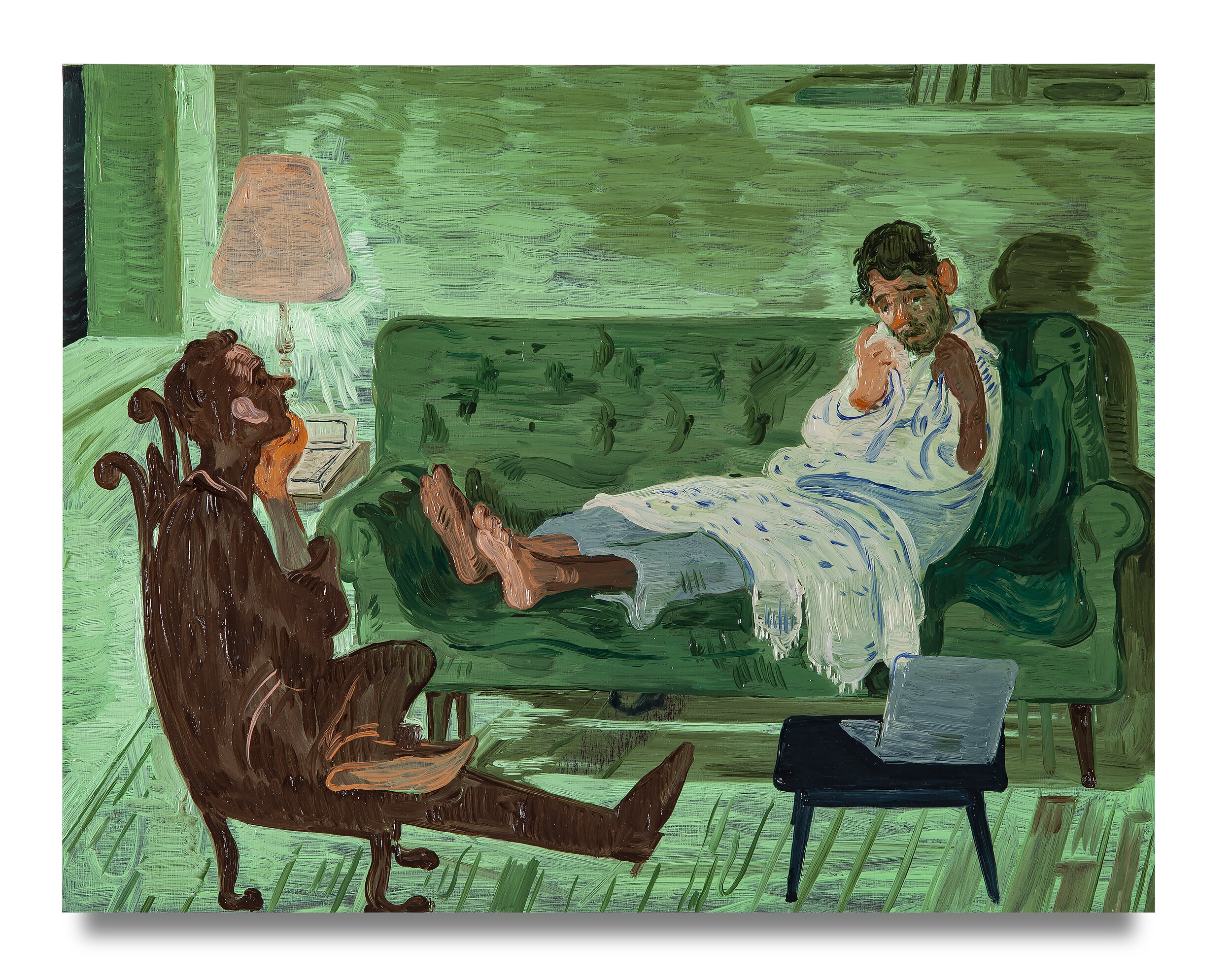SALMAN TOOR / THE ARTIST APPEARS IN NEW KOHN GALLERY GROUP SHOW, CURATED BY JOSHUA FRIEDMAN
BY GREGG LAGAMBINA
As far as anyone can know or prove, homebrewed existentialism is blossoming indoors—a philosophical trend as invisible as the poison in the air that prompted it. Like mold spores in a shower stall, a scentless gas leak, or this lingering unseeable virus, the pandemic has revealed ourselves to ourselves, whether we know it or not. The self likes it indoors. It’s why we have skulls.
This is not the semi-glamourous smoke-filled salon existentialism of the 1950s, mind you, where a bespectacled Sartre exhales cigarette smoke into a ceiling fan in Paris after a bleakly satisfying proclamation. It’s not even former Vice President Biden paraphrasing Kierkegaard at a political convention in 2020: “Faith sees best in the dark.”
Wine, medical marijuana, clonazepam, Netflix, social media, Xanax, White Claw hard seltzer, and screen-glow are among our most-common tools to numb the creeping sense of existential dread that can surface at all hours of the day, after nearly seven months of solitude. Yes, solitude. This includes you, too—families of all sizes—working a job and homeschooling and seemingly never sleeping in a house that has never felt as crowded as now. This sense of self, aloneness, the awareness that the last room in which to fully escape from whatever plagues you (in addition to the plague itself), resides in your own mind, and now that holy ground has been corrupted from without.
Friends and family will text or tell you via Zoom, “You are not alone.” They mean well. They are also lying.
“Technology allows you to be alone in a room full of people, or overconnected and alone as you isolate in your apartment,” reflects the Pakistan-born, New York-based painter Salman Toor, born 1983, whose first solo museum show at the Whitney was truncated this Spring on account of enforced closures. “I have to turn my phone off because I feel like I am in other people’s minds all the time. It moves back and forth between connection and alienation. At first, the isolation did not affect me. But a lot of my work is about living in downtown Manhattan, working in Bushwick, and that culture has stopped existing. You don’t see people on the train, walking around, or behind the counter. I thought I was losing my context. I was devising compositions and stories in my head, but I wasn’t really feeling them anymore. That was a bit panicking.”
Toor is one of over 27 artists whose work is included in Los Angeles-based Kohn Gallery’s fall exhibition, myselves, on view through the end of October. Curated by Joshua Friedman, the exhibit intends to examine how identity is crafted in isolation, living in solitude, and especially how urban quarantine can feed loneliness, even amidst thousands of other nearby bodies whose lives have turned markedly inward since sometime in March, when the entire world hit a hard pause.
“We’re constantly changing, very fluid creatures,” says Friedman. “Salman was someone whose work really interested me. He deals so much with identity and navigating his way through social constructs. Whether it’s gender, sexuality, race, or the formation of any identity, he uses his medium to really mirror that exploration. It’s very much what the entire show is about. It’s a challenge to do a show right now, but I am drawn to the physicality of the artwork and we are more restricted than ever from having physical interaction with art. When you look at [Salman’s] work, there is so much life in those images, each stroke has a pulse to it. These are living, breathing entities and I think that’s really the heart of what this show is all about.”
In a sense—and foregoing the obvious economic crunch and comparisons—independent galleries have it easier than the world’s major institutions. Nimbleness is actualizable. Yes, we all miss the romanticism of roaming high-ceilinged halls, wandering past masterpieces, the sprawling marble-floored wings, and the way that time can disappear, and centuries can collapse, in a single afternoon at the Louvre or inside The Getty. But a condition of this unprecedented isolation, and keeping with Friedman’s curatorial theme, is embracing the irrefutably contemporary, the nonreferential now.
Kohn Gallery has recently reopened by adhering to “timed reservations.” However, Kohn is not merely adapting to a health crisis. Friedman’s show is reactive, an exercise in solitary contemplation, about solitude itself—a serendipitous enhancement to a show that reveals our aloneness and how we see ourselves, by ourselves. What better way to contemplate Two Friends (2020), Toor’s study of a pair of individuals, as they form a triangle of conversation with a third presence, an open laptop. A technological imposition that has become so ever-present, it’s tempting not to describe this work as a study of three individuals.
“I like the idea of the public and the private in paintings,” says Toor, remarking on the boundary-dissolving subject matter and contexts in his paintings, or their queerness. “And how the public can invade the private. I love creating interior spaces that are very private and cozy and domestic, because I grew up in a homophobic culture. I feel the need to create safe spaces and I do that through paintings. A lot of the plushness of it, the comfort level of these interior spaces, it excites me as I paint them. I want more. These are imaginary spaces and I am just trying to imagine what I would like to have in them.
“The show includes a great group of artists, a lot of painters, figurative painters,” continues Toor. “What I got from looking at their work is this idea of what it means to be an American today, right now. It’s a lucrative question that doesn’t end.”

